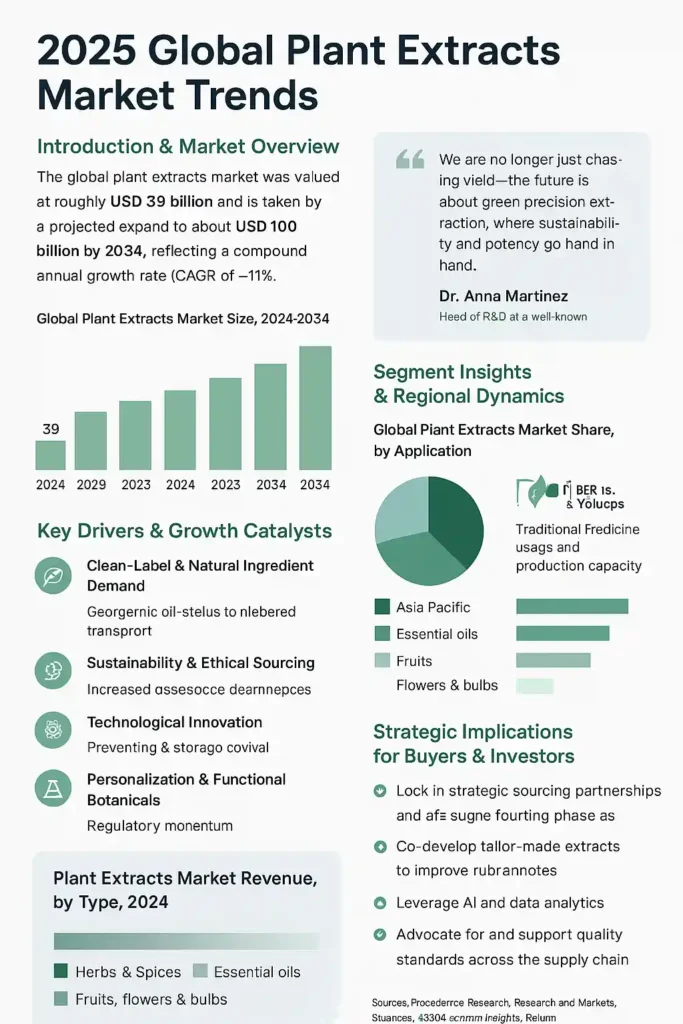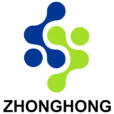Introduction & Market Overview
In 2025, the global plant extracts market is at a pivotal inflection point. According to recent industry research, its value is estimated at roughly USD 39 billion and is projected to expand to about USD 100 billion by 2034, reflecting a compound annual growth rate (CAGR) of ~11 %. Precedence Research This surge underscores not just growing demand, but a maturation of the broader botanical‑ingredient ecosystem — spanning food & beverage, cosmetics, nutraceuticals, and pharmaceuticals.
Why now? The shift is being powered by a confluence of long‑term trends: increasing consumer sophistication around “clean label” and natural products, rapid advances in green extraction technologies, and a renewed appreciation for botanical actives grounded in science and sustainability.

Key Drivers & Growth Catalysts
- Clean‑Label & Natural Ingredient Demand
Today’s consumers — particularly in North America and Europe — are demanding transparency. They favor plant-based ingredients that are traceable, responsibly sourced, and minimally processed. This demand is reshaping product formulations in food and personal care alike. - Sustainability & Ethical Sourcing
Leading extract manufacturers are investing in eco-conscious practices: organic cultivation, regenerative agriculture, fair-trade supply chains. These not only satisfy consumer ethics but also de-risk sourcing by building more resilient supplier networks. - Technological Innovation
Innovation in extraction methods is accelerating. Supercritical CO₂, ultrasonic-assisted extraction, and other solvent-free or reduced-solvent processes are delivering higher yield, purity, and lower residues — exactly what high-end nutraceutical and pharma players demand. - Personalization & Functional Botanicals
We’re seeing a strong rise in adaptogenic botanicals like ashwagandha, rhodiola, and ginseng — especially in response to stress, sleep, and cognitive-health trends. At the same time, AI-driven platforms are enabling personalized herbal supplement blends, tailored to genetic, lifestyle, and wellness profiles. - Regulatory Momentum
More markets are formalizing frameworks for botanical ingredients. Harmonization of novel-food, dietary‑supplement, and traditional medicine regulations is helping firms launch globally more efficiently. At the same time, stricter quality control standards — such as standardized extracts and validated analytical methods — are elevating industry credibility.
Segment Insights & Regional Dynamics
- By Application: Food & beverages still capture the largest share of plant extract usage, driven by natural flavors, colorants, and functional ingredients. Precedence Research+1 On the other hand, dietary supplements and pharmaceuticals are the fastest-growing segments, buoyed by wellness adoption and clinical validation.
- By Type: Traditional phytomedicines and herbal extracts remain dominant, but essential oils are slated for strong growth, especially in aromatherapy and personal care. Mordor Intelligence
- By Source: Leaves (herbs & spices) continue to be a major source, but fruits, flowers, and bulbs are gaining traction as formulators explore less-exploited botanicals. Precedence Research+1
- By Form: Powdered extract formats remain popular for nutraceutical and food applications due to their stability and shelf life, while liquid formats (e.g., oils) are expanding thanks to improved extraction methods and increasing demand in cosmetics.
- By Region:
- Asia Pacific continues to dominate in share (over 50% in the herbal extract space), driven by traditional medicine usage and strong local production capacity. Precedence Research
- North America has a premium market: high willingness to pay for clean-label, clinically validated botanicals. Mordor Intelligence
- Europe is leading on green-tech adoption and regulatory sophistication, especially around extract quality and safety.
Risks, Challenges & Strategic Risks
- Raw-Material Volatility: Many botanical raw materials are seasonal, geographically constrained, and sensitive to climate risk. This can create supply bottlenecks and price swings.
- Quality & Standardization: Non‑standardized extracts remain a risk. Without robust quality controls, impurities or inconsistent active content can hurt both safety and efficacy.
- Regulatory Barriers: While regulatory alignment is progressing, navigating different regional rules — especially for novel or lesser-known botanicals — remains complex.
- Sustainability Trade-offs: As demand surges, over-harvesting and biodiversity loss could become real concerns. Companies that don’t invest in regenerative sourcing may face backlash or long-term resource risk.
Expert Perspectives & Credibility Signals
- Dr. Anna Martinez, Head of R&D at a well-known botanical company, recently noted: “We are no longer just chasing yield — the future is about green precision extraction, where sustainability and potency go hand in hand.”
- According to a 2025 report from Research and Markets, adaptogenic botanicals are among the most in-demand categories, especially for stress‑management supplements. 环球新闻稿
- Industry-leading players like Givaudan, Symrise, Sensient, and Kangcare are heavily investing in both sustainable sourcing and advanced extraction platforms. reanin.com
Strategic Implications for Buyers & Investors
For industry buyers (like food formulators, supplement companies, or personal-care brands), 2025 offers a window of opportunity:
- Lock in strategic sourcing partnerships now — as sustainability and traceability become competitive differentiators.
- Co‑develop tailor-made extracts with technology-forward extractors to achieve high purity and unique botanical signatures.
- Leverage AI and data analytics to build personalized botanical products — helping you differentiate in a crowded wellness market.
- Advocate for and support quality standards across your supply chain to future-proof your brand against regulatory risk and quality recalls.
Conclusion
The global plant extracts market in 2025 is not just large — it’s evolving rapidly. It’s becoming more scientifically rigorous, ethically grounded, and strategically segmented. For industry buyers, this evolution means more opportunity — but also higher expectations. Those who align with sustainable sourcing, innovation, and quality can ride this wave into a future where botanicals are not just “natural,” but next‑generation ingredients for global wellness, food, and pharma innovation.
References
- Precedence Research, “Plant Extracts Market Size, Share and Trends 2025 to 2034” Precedence Research
- Research and Markets, “Plant Extracts Industry Report 2025-2034” 环球新闻稿
- Statifacts, “Herbal Extract Market Statistics 2025–2034” Statifacts
- Global Growth Insights, “Pharmaceutical Plant Extracts Market” 全球增长洞察
- Reanin, “Plant Extracts Market Insights & Trends” reanin.com
